Assignment (Doc) | Psychology Theory
VerifiedAdded on 2022/10/07
|14
|3999
|33
Assignment
AI Summary
Attemp the first slide question
Contribute Materials
Your contribution can guide someone’s learning journey. Share your
documents today.

RUNNING HEAD: PSYCHOLOGY 0
Psychology
8/10/2019
Robinson and Berridge’s Incentive Sensitisation Model of Drug Addiction
Psychology
8/10/2019
Robinson and Berridge’s Incentive Sensitisation Model of Drug Addiction
Secure Best Marks with AI Grader
Need help grading? Try our AI Grader for instant feedback on your assignments.
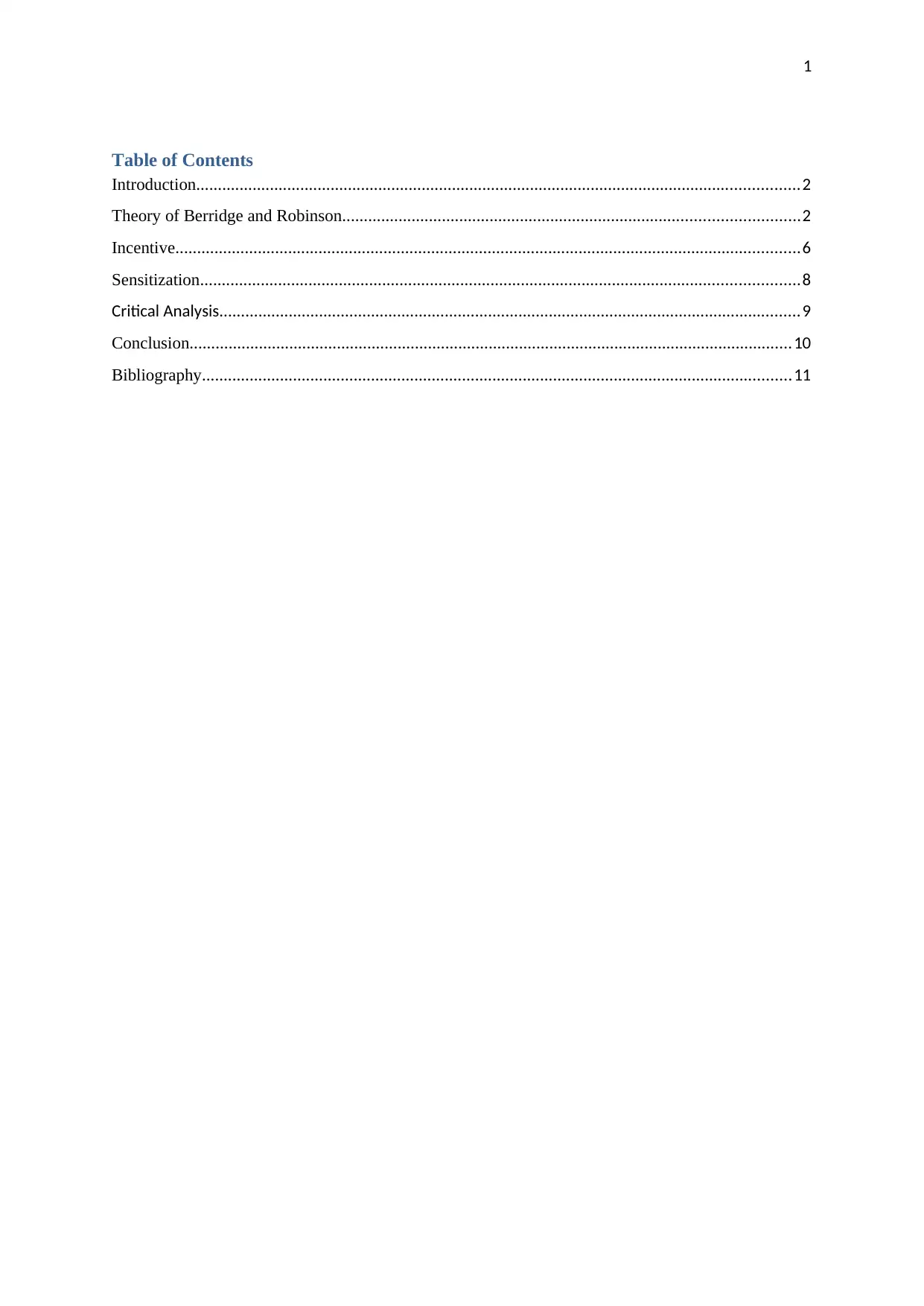
1
Table of Contents
Introduction...........................................................................................................................................2
Theory of Berridge and Robinson.........................................................................................................2
Incentive................................................................................................................................................6
Sensitization..........................................................................................................................................8
Critical Analysis......................................................................................................................................9
Conclusion...........................................................................................................................................10
Bibliography........................................................................................................................................11
Table of Contents
Introduction...........................................................................................................................................2
Theory of Berridge and Robinson.........................................................................................................2
Incentive................................................................................................................................................6
Sensitization..........................................................................................................................................8
Critical Analysis......................................................................................................................................9
Conclusion...........................................................................................................................................10
Bibliography........................................................................................................................................11
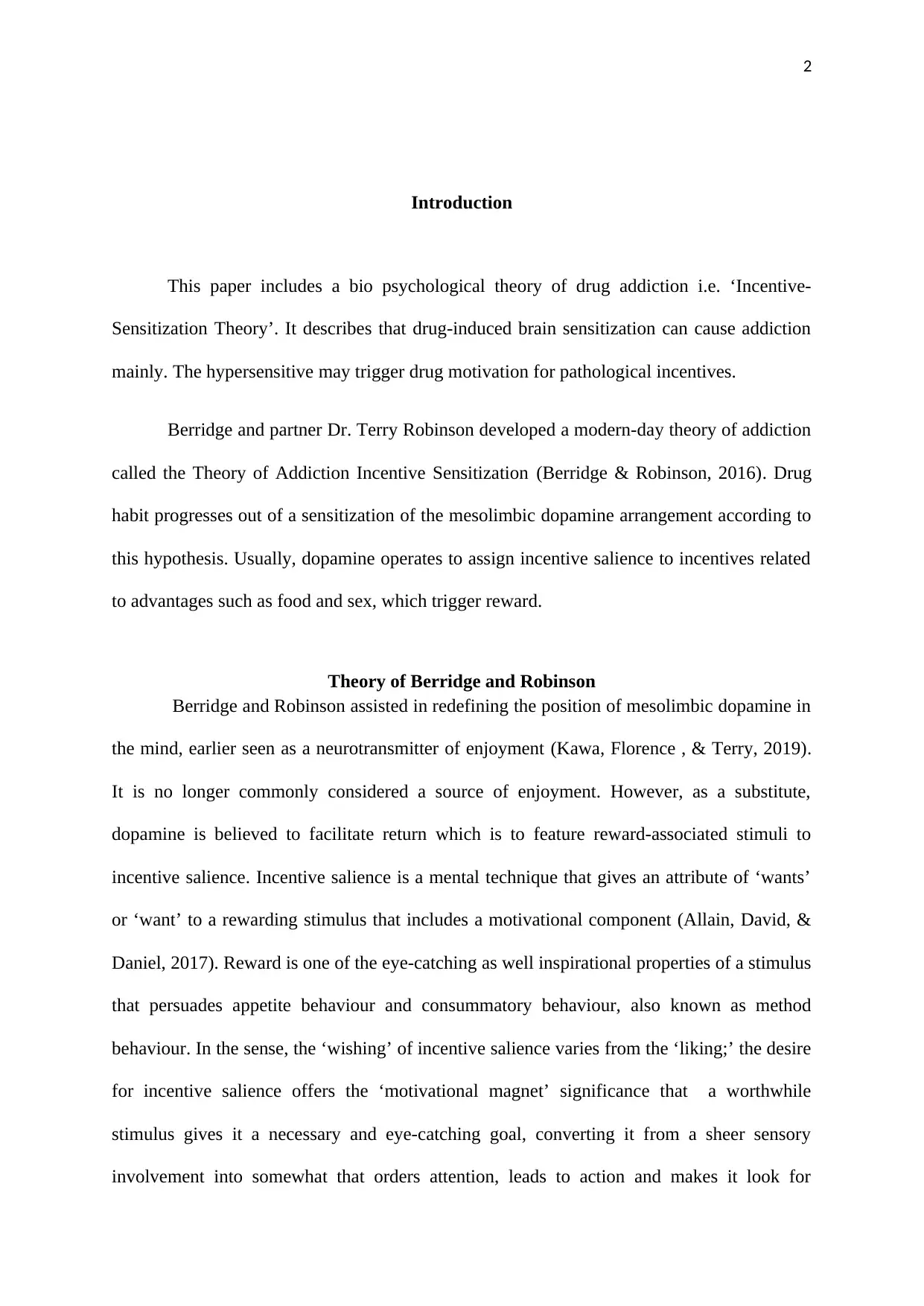
2
Introduction
This paper includes a bio psychological theory of drug addiction i.e. ‘Incentive-
Sensitization Theory’. It describes that drug-induced brain sensitization can cause addiction
mainly. The hypersensitive may trigger drug motivation for pathological incentives.
Berridge and partner Dr. Terry Robinson developed a modern-day theory of addiction
called the Theory of Addiction Incentive Sensitization (Berridge & Robinson, 2016). Drug
habit progresses out of a sensitization of the mesolimbic dopamine arrangement according to
this hypothesis. Usually, dopamine operates to assign incentive salience to incentives related
to advantages such as food and sex, which trigger reward.
Theory of Berridge and Robinson
Berridge and Robinson assisted in redefining the position of mesolimbic dopamine in
the mind, earlier seen as a neurotransmitter of enjoyment (Kawa, Florence , & Terry, 2019).
It is no longer commonly considered a source of enjoyment. However, as a substitute,
dopamine is believed to facilitate return which is to feature reward-associated stimuli to
incentive salience. Incentive salience is a mental technique that gives an attribute of ‘wants’
or ‘want’ to a rewarding stimulus that includes a motivational component (Allain, David, &
Daniel, 2017). Reward is one of the eye-catching as well inspirational properties of a stimulus
that persuades appetite behaviour and consummatory behaviour, also known as method
behaviour. In the sense, the ‘wishing’ of incentive salience varies from the ‘liking;’ the desire
for incentive salience offers the ‘motivational magnet’ significance that a worthwhile
stimulus gives it a necessary and eye-catching goal, converting it from a sheer sensory
involvement into somewhat that orders attention, leads to action and makes it look for
Introduction
This paper includes a bio psychological theory of drug addiction i.e. ‘Incentive-
Sensitization Theory’. It describes that drug-induced brain sensitization can cause addiction
mainly. The hypersensitive may trigger drug motivation for pathological incentives.
Berridge and partner Dr. Terry Robinson developed a modern-day theory of addiction
called the Theory of Addiction Incentive Sensitization (Berridge & Robinson, 2016). Drug
habit progresses out of a sensitization of the mesolimbic dopamine arrangement according to
this hypothesis. Usually, dopamine operates to assign incentive salience to incentives related
to advantages such as food and sex, which trigger reward.
Theory of Berridge and Robinson
Berridge and Robinson assisted in redefining the position of mesolimbic dopamine in
the mind, earlier seen as a neurotransmitter of enjoyment (Kawa, Florence , & Terry, 2019).
It is no longer commonly considered a source of enjoyment. However, as a substitute,
dopamine is believed to facilitate return which is to feature reward-associated stimuli to
incentive salience. Incentive salience is a mental technique that gives an attribute of ‘wants’
or ‘want’ to a rewarding stimulus that includes a motivational component (Allain, David, &
Daniel, 2017). Reward is one of the eye-catching as well inspirational properties of a stimulus
that persuades appetite behaviour and consummatory behaviour, also known as method
behaviour. In the sense, the ‘wishing’ of incentive salience varies from the ‘liking;’ the desire
for incentive salience offers the ‘motivational magnet’ significance that a worthwhile
stimulus gives it a necessary and eye-catching goal, converting it from a sheer sensory
involvement into somewhat that orders attention, leads to action and makes it look for
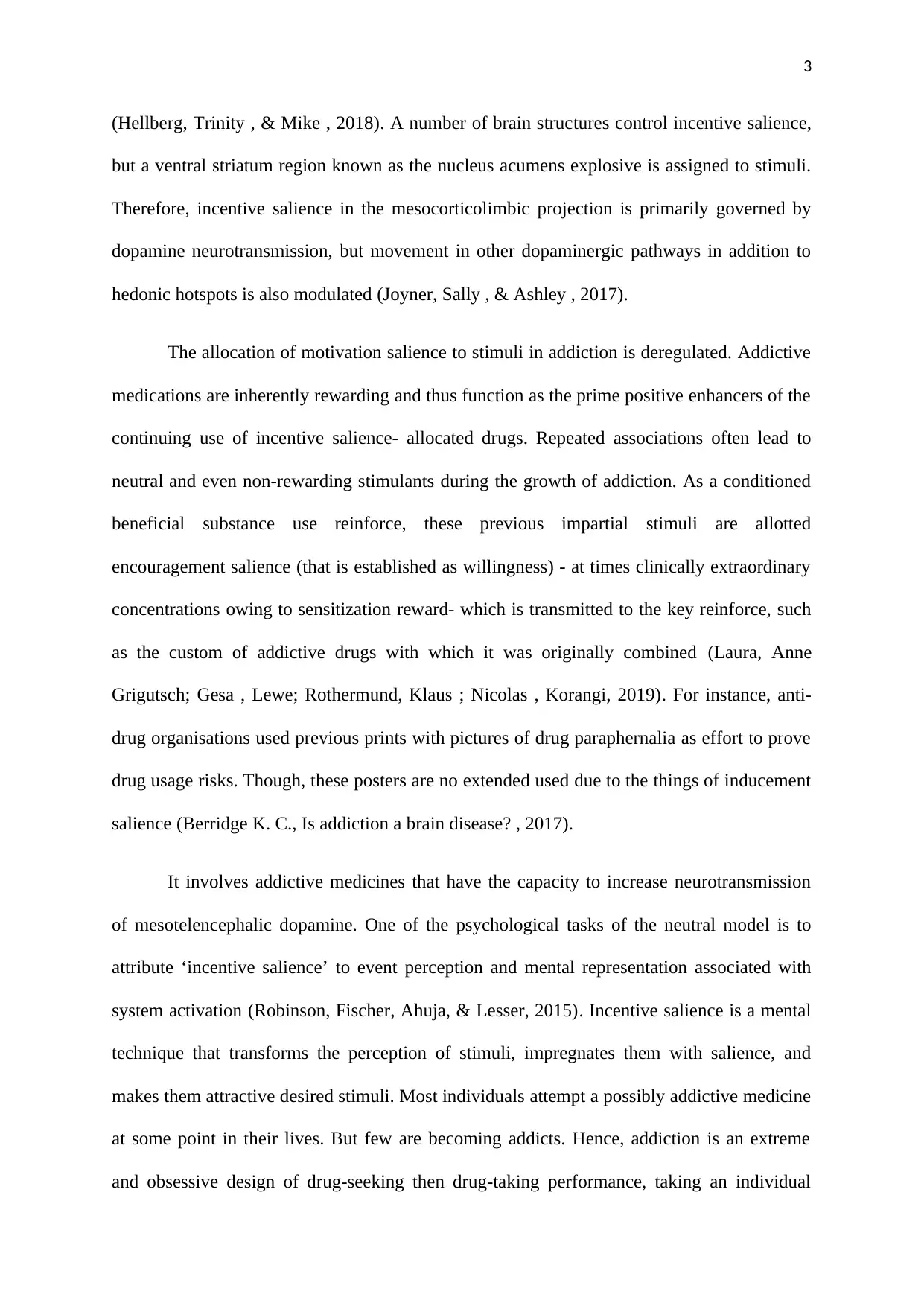
3
(Hellberg, Trinity , & Mike , 2018). A number of brain structures control incentive salience,
but a ventral striatum region known as the nucleus acumens explosive is assigned to stimuli.
Therefore, incentive salience in the mesocorticolimbic projection is primarily governed by
dopamine neurotransmission, but movement in other dopaminergic pathways in addition to
hedonic hotspots is also modulated (Joyner, Sally , & Ashley , 2017).
The allocation of motivation salience to stimuli in addiction is deregulated. Addictive
medications are inherently rewarding and thus function as the prime positive enhancers of the
continuing use of incentive salience- allocated drugs. Repeated associations often lead to
neutral and even non-rewarding stimulants during the growth of addiction. As a conditioned
beneficial substance use reinforce, these previous impartial stimuli are allotted
encouragement salience (that is established as willingness) - at times clinically extraordinary
concentrations owing to sensitization reward- which is transmitted to the key reinforce, such
as the custom of addictive drugs with which it was originally combined (Laura, Anne
Grigutsch; Gesa , Lewe; Rothermund, Klaus ; Nicolas , Korangi, 2019). For instance, anti-
drug organisations used previous prints with pictures of drug paraphernalia as effort to prove
drug usage risks. Though, these posters are no extended used due to the things of inducement
salience (Berridge K. C., Is addiction a brain disease? , 2017).
It involves addictive medicines that have the capacity to increase neurotransmission
of mesotelencephalic dopamine. One of the psychological tasks of the neutral model is to
attribute ‘incentive salience’ to event perception and mental representation associated with
system activation (Robinson, Fischer, Ahuja, & Lesser, 2015). Incentive salience is a mental
technique that transforms the perception of stimuli, impregnates them with salience, and
makes them attractive desired stimuli. Most individuals attempt a possibly addictive medicine
at some point in their lives. But few are becoming addicts. Hence, addiction is an extreme
and obsessive design of drug-seeking then drug-taking performance, taking an individual
(Hellberg, Trinity , & Mike , 2018). A number of brain structures control incentive salience,
but a ventral striatum region known as the nucleus acumens explosive is assigned to stimuli.
Therefore, incentive salience in the mesocorticolimbic projection is primarily governed by
dopamine neurotransmission, but movement in other dopaminergic pathways in addition to
hedonic hotspots is also modulated (Joyner, Sally , & Ashley , 2017).
The allocation of motivation salience to stimuli in addiction is deregulated. Addictive
medications are inherently rewarding and thus function as the prime positive enhancers of the
continuing use of incentive salience- allocated drugs. Repeated associations often lead to
neutral and even non-rewarding stimulants during the growth of addiction. As a conditioned
beneficial substance use reinforce, these previous impartial stimuli are allotted
encouragement salience (that is established as willingness) - at times clinically extraordinary
concentrations owing to sensitization reward- which is transmitted to the key reinforce, such
as the custom of addictive drugs with which it was originally combined (Laura, Anne
Grigutsch; Gesa , Lewe; Rothermund, Klaus ; Nicolas , Korangi, 2019). For instance, anti-
drug organisations used previous prints with pictures of drug paraphernalia as effort to prove
drug usage risks. Though, these posters are no extended used due to the things of inducement
salience (Berridge K. C., Is addiction a brain disease? , 2017).
It involves addictive medicines that have the capacity to increase neurotransmission
of mesotelencephalic dopamine. One of the psychological tasks of the neutral model is to
attribute ‘incentive salience’ to event perception and mental representation associated with
system activation (Robinson, Fischer, Ahuja, & Lesser, 2015). Incentive salience is a mental
technique that transforms the perception of stimuli, impregnates them with salience, and
makes them attractive desired stimuli. Most individuals attempt a possibly addictive medicine
at some point in their lives. But few are becoming addicts. Hence, addiction is an extreme
and obsessive design of drug-seeking then drug-taking performance, taking an individual
Secure Best Marks with AI Grader
Need help grading? Try our AI Grader for instant feedback on your assignments.
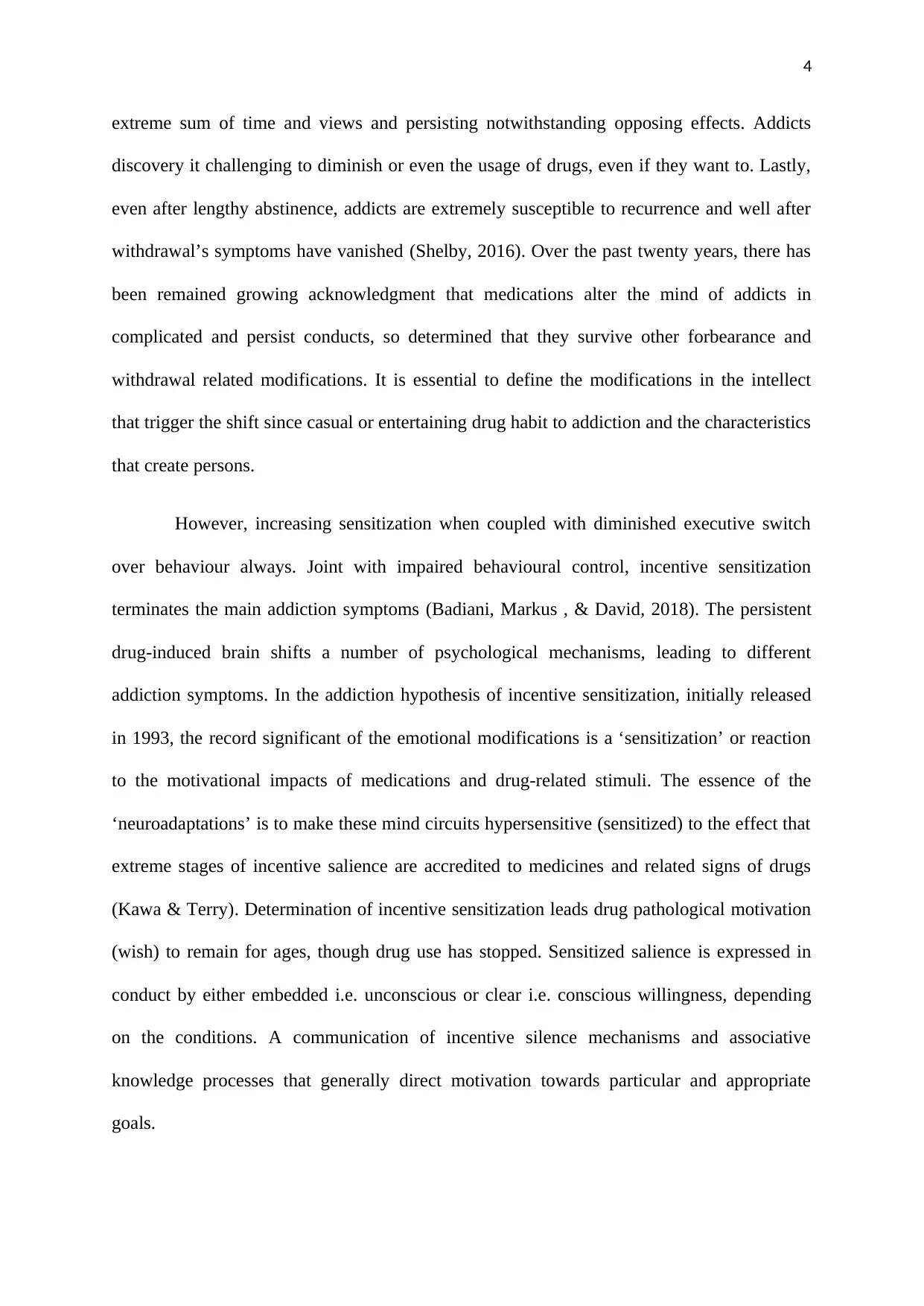
4
extreme sum of time and views and persisting notwithstanding opposing effects. Addicts
discovery it challenging to diminish or even the usage of drugs, even if they want to. Lastly,
even after lengthy abstinence, addicts are extremely susceptible to recurrence and well after
withdrawal’s symptoms have vanished (Shelby, 2016). Over the past twenty years, there has
been remained growing acknowledgment that medications alter the mind of addicts in
complicated and persist conducts, so determined that they survive other forbearance and
withdrawal related modifications. It is essential to define the modifications in the intellect
that trigger the shift since casual or entertaining drug habit to addiction and the characteristics
that create persons.
However, increasing sensitization when coupled with diminished executive switch
over behaviour always. Joint with impaired behavioural control, incentive sensitization
terminates the main addiction symptoms (Badiani, Markus , & David, 2018). The persistent
drug-induced brain shifts a number of psychological mechanisms, leading to different
addiction symptoms. In the addiction hypothesis of incentive sensitization, initially released
in 1993, the record significant of the emotional modifications is a ‘sensitization’ or reaction
to the motivational impacts of medications and drug-related stimuli. The essence of the
‘neuroadaptations’ is to make these mind circuits hypersensitive (sensitized) to the effect that
extreme stages of incentive salience are accredited to medicines and related signs of drugs
(Kawa & Terry). Determination of incentive sensitization leads drug pathological motivation
(wish) to remain for ages, though drug use has stopped. Sensitized salience is expressed in
conduct by either embedded i.e. unconscious or clear i.e. conscious willingness, depending
on the conditions. A communication of incentive silence mechanisms and associative
knowledge processes that generally direct motivation towards particular and appropriate
goals.
extreme sum of time and views and persisting notwithstanding opposing effects. Addicts
discovery it challenging to diminish or even the usage of drugs, even if they want to. Lastly,
even after lengthy abstinence, addicts are extremely susceptible to recurrence and well after
withdrawal’s symptoms have vanished (Shelby, 2016). Over the past twenty years, there has
been remained growing acknowledgment that medications alter the mind of addicts in
complicated and persist conducts, so determined that they survive other forbearance and
withdrawal related modifications. It is essential to define the modifications in the intellect
that trigger the shift since casual or entertaining drug habit to addiction and the characteristics
that create persons.
However, increasing sensitization when coupled with diminished executive switch
over behaviour always. Joint with impaired behavioural control, incentive sensitization
terminates the main addiction symptoms (Badiani, Markus , & David, 2018). The persistent
drug-induced brain shifts a number of psychological mechanisms, leading to different
addiction symptoms. In the addiction hypothesis of incentive sensitization, initially released
in 1993, the record significant of the emotional modifications is a ‘sensitization’ or reaction
to the motivational impacts of medications and drug-related stimuli. The essence of the
‘neuroadaptations’ is to make these mind circuits hypersensitive (sensitized) to the effect that
extreme stages of incentive salience are accredited to medicines and related signs of drugs
(Kawa & Terry). Determination of incentive sensitization leads drug pathological motivation
(wish) to remain for ages, though drug use has stopped. Sensitized salience is expressed in
conduct by either embedded i.e. unconscious or clear i.e. conscious willingness, depending
on the conditions. A communication of incentive silence mechanisms and associative
knowledge processes that generally direct motivation towards particular and appropriate
goals.

5
Also, there are claims that pathological motivation stems from brain circuit
sensitization that mediates Pavlovian conditioned motivational incentive mechanisms (i.e.
sensitization of incentives). Still, significance to highlight that associative knowledge
processes curbs the appearance of behavioural neural sensitization at precise spaces or times
(none at other times) and guide the route. Finally, by extending outside the associated focus
of wishing for drug goals, incentive sensitization can sometimes also roll into other goals
such as food, sexual role, gambling, etc. Calling addiction a ‘leading disorder’ has become
common, but we believe this term maybe too small to suit truth. Learning is first element of
the procedure and perhaps not the utmost important element of the drug pathology. Learning
can be regarded in a top-down fashion as layered on fundamental mechanisms of
sensitization, analogous to how knowledge controls face of non-associative mechanisms of
motivation such as pressure and agony. Background controls on sensitization look provide
additional processes to explain why the addicts ‘want’ medications mainly when they are
context of drug-associated therapy. The peak significant sort of ‘learning theory’
recommends that medications encourage the study of strong ‘automated’ stimulus-response
(S-R) habits then it is presumed that S-R habits confer behavioural compulsiveness by nature.
It is hard to imagine, however, how any effect of medicinal products on teaching
procedures alone could make behaviour compulsive, unless there was also an extra
motivational element engaged, and motivational variables do not modulates S-R practices by
definition. Solid S-R habits do not essentially main to habitual conduct: most individuals do
not perform compulsive actions such as tying up of shoes, cleaning teeth, etc., even after
more performances (Jahns & Roemmich, 2016). The extra motivational processes seem to
elucidate why a drug- free addict’s wakes up in the dawn devotes the day in a difficult and
occasionally new set of activities such as stealing for drug procurement. Addicts do what they
need to do and go where they need to go to get drugs, even though there have never been any
Also, there are claims that pathological motivation stems from brain circuit
sensitization that mediates Pavlovian conditioned motivational incentive mechanisms (i.e.
sensitization of incentives). Still, significance to highlight that associative knowledge
processes curbs the appearance of behavioural neural sensitization at precise spaces or times
(none at other times) and guide the route. Finally, by extending outside the associated focus
of wishing for drug goals, incentive sensitization can sometimes also roll into other goals
such as food, sexual role, gambling, etc. Calling addiction a ‘leading disorder’ has become
common, but we believe this term maybe too small to suit truth. Learning is first element of
the procedure and perhaps not the utmost important element of the drug pathology. Learning
can be regarded in a top-down fashion as layered on fundamental mechanisms of
sensitization, analogous to how knowledge controls face of non-associative mechanisms of
motivation such as pressure and agony. Background controls on sensitization look provide
additional processes to explain why the addicts ‘want’ medications mainly when they are
context of drug-associated therapy. The peak significant sort of ‘learning theory’
recommends that medications encourage the study of strong ‘automated’ stimulus-response
(S-R) habits then it is presumed that S-R habits confer behavioural compulsiveness by nature.
It is hard to imagine, however, how any effect of medicinal products on teaching
procedures alone could make behaviour compulsive, unless there was also an extra
motivational element engaged, and motivational variables do not modulates S-R practices by
definition. Solid S-R habits do not essentially main to habitual conduct: most individuals do
not perform compulsive actions such as tying up of shoes, cleaning teeth, etc., even after
more performances (Jahns & Roemmich, 2016). The extra motivational processes seem to
elucidate why a drug- free addict’s wakes up in the dawn devotes the day in a difficult and
occasionally new set of activities such as stealing for drug procurement. Addicts do what they
need to do and go where they need to go to get drugs, even though there have never been any
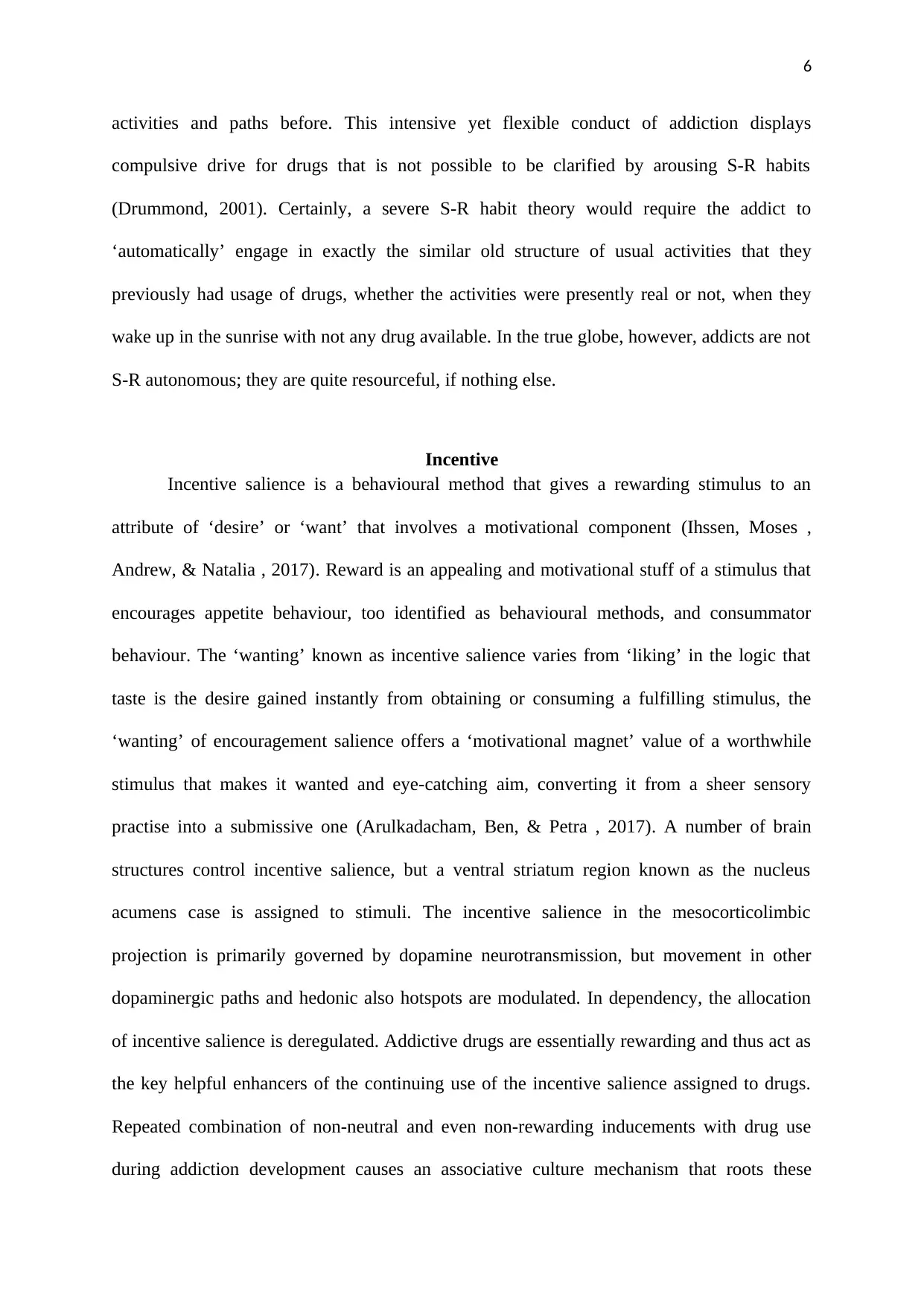
6
activities and paths before. This intensive yet flexible conduct of addiction displays
compulsive drive for drugs that is not possible to be clarified by arousing S-R habits
(Drummond, 2001). Certainly, a severe S-R habit theory would require the addict to
‘automatically’ engage in exactly the similar old structure of usual activities that they
previously had usage of drugs, whether the activities were presently real or not, when they
wake up in the sunrise with not any drug available. In the true globe, however, addicts are not
S-R autonomous; they are quite resourceful, if nothing else.
Incentive
Incentive salience is a behavioural method that gives a rewarding stimulus to an
attribute of ‘desire’ or ‘want’ that involves a motivational component (Ihssen, Moses ,
Andrew, & Natalia , 2017). Reward is an appealing and motivational stuff of a stimulus that
encourages appetite behaviour, too identified as behavioural methods, and consummator
behaviour. The ‘wanting’ known as incentive salience varies from ‘liking’ in the logic that
taste is the desire gained instantly from obtaining or consuming a fulfilling stimulus, the
‘wanting’ of encouragement salience offers a ‘motivational magnet’ value of a worthwhile
stimulus that makes it wanted and eye-catching aim, converting it from a sheer sensory
practise into a submissive one (Arulkadacham, Ben, & Petra , 2017). A number of brain
structures control incentive salience, but a ventral striatum region known as the nucleus
acumens case is assigned to stimuli. The incentive salience in the mesocorticolimbic
projection is primarily governed by dopamine neurotransmission, but movement in other
dopaminergic paths and hedonic also hotspots are modulated. In dependency, the allocation
of incentive salience is deregulated. Addictive drugs are essentially rewarding and thus act as
the key helpful enhancers of the continuing use of the incentive salience assigned to drugs.
Repeated combination of non-neutral and even non-rewarding inducements with drug use
during addiction development causes an associative culture mechanism that roots these
activities and paths before. This intensive yet flexible conduct of addiction displays
compulsive drive for drugs that is not possible to be clarified by arousing S-R habits
(Drummond, 2001). Certainly, a severe S-R habit theory would require the addict to
‘automatically’ engage in exactly the similar old structure of usual activities that they
previously had usage of drugs, whether the activities were presently real or not, when they
wake up in the sunrise with not any drug available. In the true globe, however, addicts are not
S-R autonomous; they are quite resourceful, if nothing else.
Incentive
Incentive salience is a behavioural method that gives a rewarding stimulus to an
attribute of ‘desire’ or ‘want’ that involves a motivational component (Ihssen, Moses ,
Andrew, & Natalia , 2017). Reward is an appealing and motivational stuff of a stimulus that
encourages appetite behaviour, too identified as behavioural methods, and consummator
behaviour. The ‘wanting’ known as incentive salience varies from ‘liking’ in the logic that
taste is the desire gained instantly from obtaining or consuming a fulfilling stimulus, the
‘wanting’ of encouragement salience offers a ‘motivational magnet’ value of a worthwhile
stimulus that makes it wanted and eye-catching aim, converting it from a sheer sensory
practise into a submissive one (Arulkadacham, Ben, & Petra , 2017). A number of brain
structures control incentive salience, but a ventral striatum region known as the nucleus
acumens case is assigned to stimuli. The incentive salience in the mesocorticolimbic
projection is primarily governed by dopamine neurotransmission, but movement in other
dopaminergic paths and hedonic also hotspots are modulated. In dependency, the allocation
of incentive salience is deregulated. Addictive drugs are essentially rewarding and thus act as
the key helpful enhancers of the continuing use of the incentive salience assigned to drugs.
Repeated combination of non-neutral and even non-rewarding inducements with drug use
during addiction development causes an associative culture mechanism that roots these
Paraphrase This Document
Need a fresh take? Get an instant paraphrase of this document with our AI Paraphraser
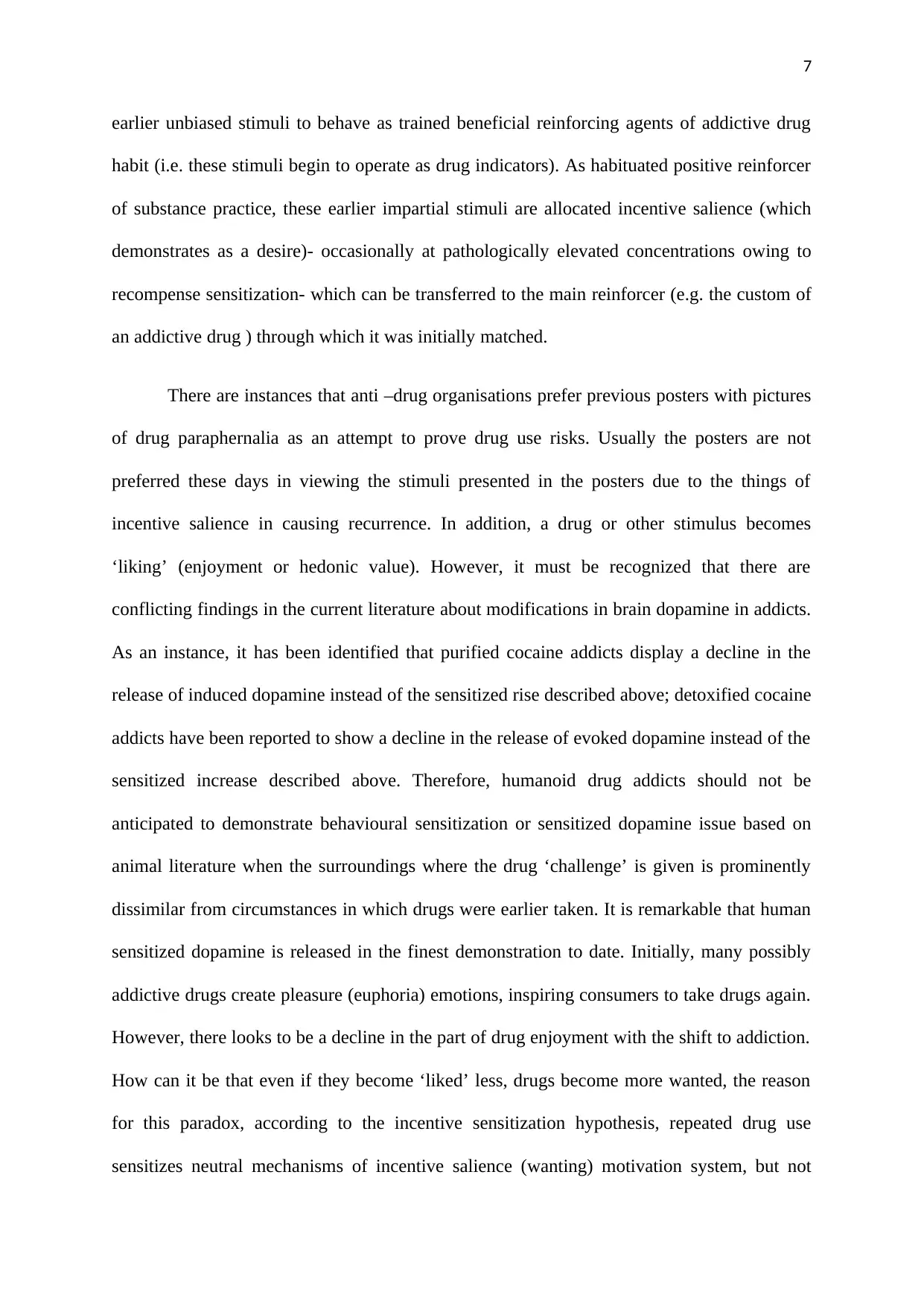
7
earlier unbiased stimuli to behave as trained beneficial reinforcing agents of addictive drug
habit (i.e. these stimuli begin to operate as drug indicators). As habituated positive reinforcer
of substance practice, these earlier impartial stimuli are allocated incentive salience (which
demonstrates as a desire)- occasionally at pathologically elevated concentrations owing to
recompense sensitization- which can be transferred to the main reinforcer (e.g. the custom of
an addictive drug ) through which it was initially matched.
There are instances that anti –drug organisations prefer previous posters with pictures
of drug paraphernalia as an attempt to prove drug use risks. Usually the posters are not
preferred these days in viewing the stimuli presented in the posters due to the things of
incentive salience in causing recurrence. In addition, a drug or other stimulus becomes
‘liking’ (enjoyment or hedonic value). However, it must be recognized that there are
conflicting findings in the current literature about modifications in brain dopamine in addicts.
As an instance, it has been identified that purified cocaine addicts display a decline in the
release of induced dopamine instead of the sensitized rise described above; detoxified cocaine
addicts have been reported to show a decline in the release of evoked dopamine instead of the
sensitized increase described above. Therefore, humanoid drug addicts should not be
anticipated to demonstrate behavioural sensitization or sensitized dopamine issue based on
animal literature when the surroundings where the drug ‘challenge’ is given is prominently
dissimilar from circumstances in which drugs were earlier taken. It is remarkable that human
sensitized dopamine is released in the finest demonstration to date. Initially, many possibly
addictive drugs create pleasure (euphoria) emotions, inspiring consumers to take drugs again.
However, there looks to be a decline in the part of drug enjoyment with the shift to addiction.
How can it be that even if they become ‘liked’ less, drugs become more wanted, the reason
for this paradox, according to the incentive sensitization hypothesis, repeated drug use
sensitizes neutral mechanisms of incentive salience (wanting) motivation system, but not
earlier unbiased stimuli to behave as trained beneficial reinforcing agents of addictive drug
habit (i.e. these stimuli begin to operate as drug indicators). As habituated positive reinforcer
of substance practice, these earlier impartial stimuli are allocated incentive salience (which
demonstrates as a desire)- occasionally at pathologically elevated concentrations owing to
recompense sensitization- which can be transferred to the main reinforcer (e.g. the custom of
an addictive drug ) through which it was initially matched.
There are instances that anti –drug organisations prefer previous posters with pictures
of drug paraphernalia as an attempt to prove drug use risks. Usually the posters are not
preferred these days in viewing the stimuli presented in the posters due to the things of
incentive salience in causing recurrence. In addition, a drug or other stimulus becomes
‘liking’ (enjoyment or hedonic value). However, it must be recognized that there are
conflicting findings in the current literature about modifications in brain dopamine in addicts.
As an instance, it has been identified that purified cocaine addicts display a decline in the
release of induced dopamine instead of the sensitized rise described above; detoxified cocaine
addicts have been reported to show a decline in the release of evoked dopamine instead of the
sensitized increase described above. Therefore, humanoid drug addicts should not be
anticipated to demonstrate behavioural sensitization or sensitized dopamine issue based on
animal literature when the surroundings where the drug ‘challenge’ is given is prominently
dissimilar from circumstances in which drugs were earlier taken. It is remarkable that human
sensitized dopamine is released in the finest demonstration to date. Initially, many possibly
addictive drugs create pleasure (euphoria) emotions, inspiring consumers to take drugs again.
However, there looks to be a decline in the part of drug enjoyment with the shift to addiction.
How can it be that even if they become ‘liked’ less, drugs become more wanted, the reason
for this paradox, according to the incentive sensitization hypothesis, repeated drug use
sensitizes neutral mechanisms of incentive salience (wanting) motivation system, but not
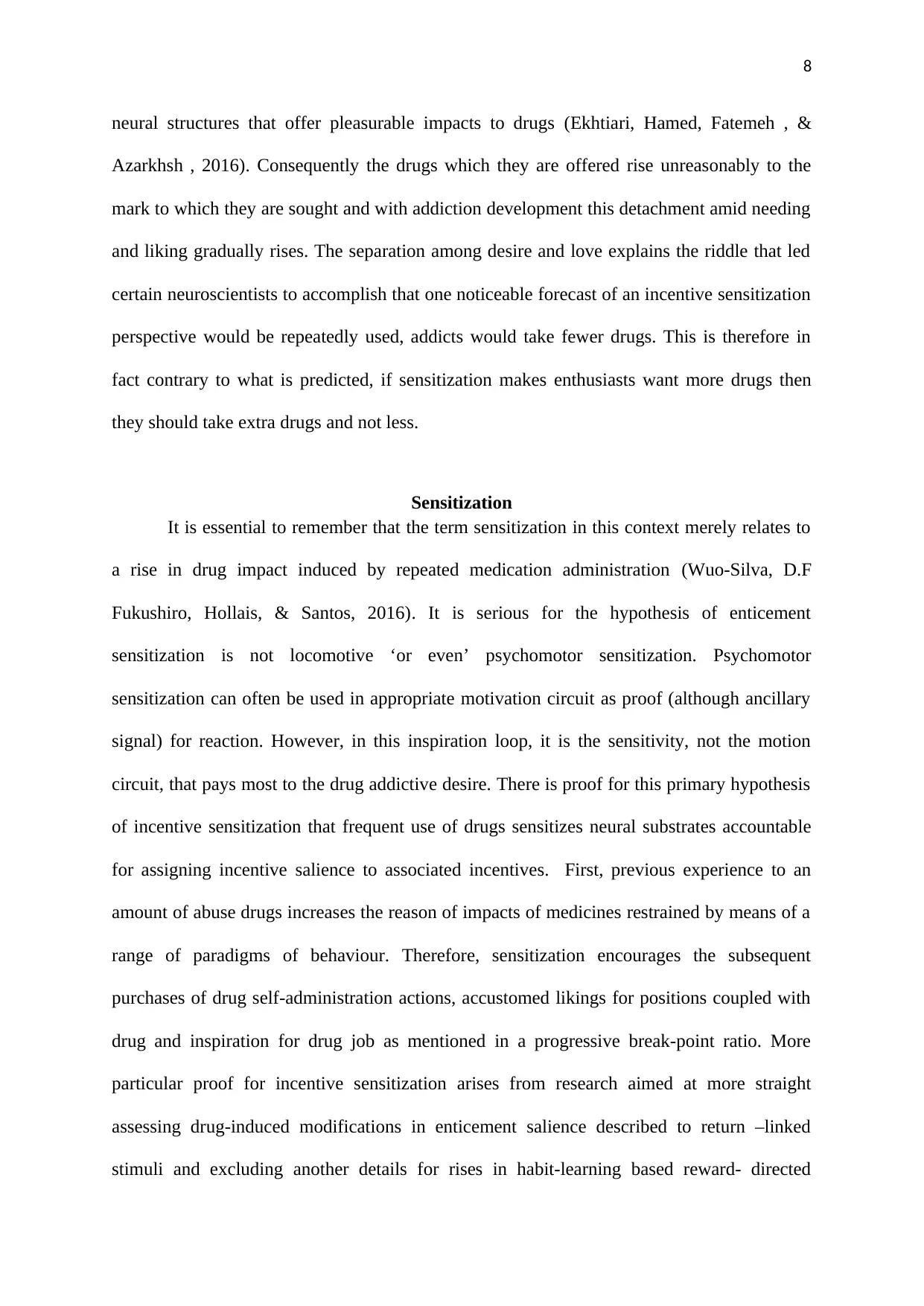
8
neural structures that offer pleasurable impacts to drugs (Ekhtiari, Hamed, Fatemeh , &
Azarkhsh , 2016). Consequently the drugs which they are offered rise unreasonably to the
mark to which they are sought and with addiction development this detachment amid needing
and liking gradually rises. The separation among desire and love explains the riddle that led
certain neuroscientists to accomplish that one noticeable forecast of an incentive sensitization
perspective would be repeatedly used, addicts would take fewer drugs. This is therefore in
fact contrary to what is predicted, if sensitization makes enthusiasts want more drugs then
they should take extra drugs and not less.
Sensitization
It is essential to remember that the term sensitization in this context merely relates to
a rise in drug impact induced by repeated medication administration (Wuo-Silva, D.F
Fukushiro, Hollais, & Santos, 2016). It is serious for the hypothesis of enticement
sensitization is not locomotive ‘or even’ psychomotor sensitization. Psychomotor
sensitization can often be used in appropriate motivation circuit as proof (although ancillary
signal) for reaction. However, in this inspiration loop, it is the sensitivity, not the motion
circuit, that pays most to the drug addictive desire. There is proof for this primary hypothesis
of incentive sensitization that frequent use of drugs sensitizes neural substrates accountable
for assigning incentive salience to associated incentives. First, previous experience to an
amount of abuse drugs increases the reason of impacts of medicines restrained by means of a
range of paradigms of behaviour. Therefore, sensitization encourages the subsequent
purchases of drug self-administration actions, accustomed likings for positions coupled with
drug and inspiration for drug job as mentioned in a progressive break-point ratio. More
particular proof for incentive sensitization arises from research aimed at more straight
assessing drug-induced modifications in enticement salience described to return –linked
stimuli and excluding another details for rises in habit-learning based reward- directed
neural structures that offer pleasurable impacts to drugs (Ekhtiari, Hamed, Fatemeh , &
Azarkhsh , 2016). Consequently the drugs which they are offered rise unreasonably to the
mark to which they are sought and with addiction development this detachment amid needing
and liking gradually rises. The separation among desire and love explains the riddle that led
certain neuroscientists to accomplish that one noticeable forecast of an incentive sensitization
perspective would be repeatedly used, addicts would take fewer drugs. This is therefore in
fact contrary to what is predicted, if sensitization makes enthusiasts want more drugs then
they should take extra drugs and not less.
Sensitization
It is essential to remember that the term sensitization in this context merely relates to
a rise in drug impact induced by repeated medication administration (Wuo-Silva, D.F
Fukushiro, Hollais, & Santos, 2016). It is serious for the hypothesis of enticement
sensitization is not locomotive ‘or even’ psychomotor sensitization. Psychomotor
sensitization can often be used in appropriate motivation circuit as proof (although ancillary
signal) for reaction. However, in this inspiration loop, it is the sensitivity, not the motion
circuit, that pays most to the drug addictive desire. There is proof for this primary hypothesis
of incentive sensitization that frequent use of drugs sensitizes neural substrates accountable
for assigning incentive salience to associated incentives. First, previous experience to an
amount of abuse drugs increases the reason of impacts of medicines restrained by means of a
range of paradigms of behaviour. Therefore, sensitization encourages the subsequent
purchases of drug self-administration actions, accustomed likings for positions coupled with
drug and inspiration for drug job as mentioned in a progressive break-point ratio. More
particular proof for incentive sensitization arises from research aimed at more straight
assessing drug-induced modifications in enticement salience described to return –linked
stimuli and excluding another details for rises in habit-learning based reward- directed
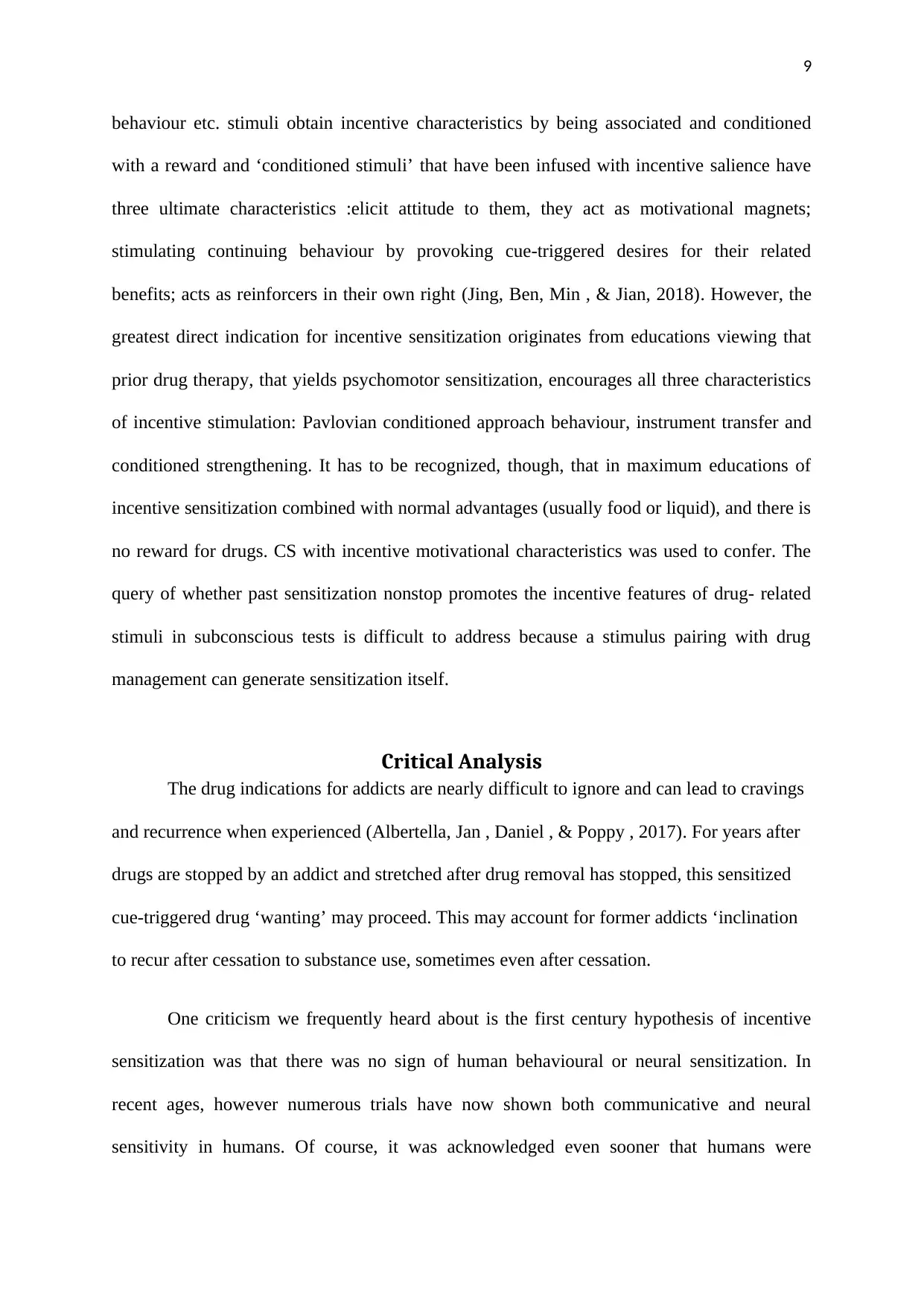
9
behaviour etc. stimuli obtain incentive characteristics by being associated and conditioned
with a reward and ‘conditioned stimuli’ that have been infused with incentive salience have
three ultimate characteristics :elicit attitude to them, they act as motivational magnets;
stimulating continuing behaviour by provoking cue-triggered desires for their related
benefits; acts as reinforcers in their own right (Jing, Ben, Min , & Jian, 2018). However, the
greatest direct indication for incentive sensitization originates from educations viewing that
prior drug therapy, that yields psychomotor sensitization, encourages all three characteristics
of incentive stimulation: Pavlovian conditioned approach behaviour, instrument transfer and
conditioned strengthening. It has to be recognized, though, that in maximum educations of
incentive sensitization combined with normal advantages (usually food or liquid), and there is
no reward for drugs. CS with incentive motivational characteristics was used to confer. The
query of whether past sensitization nonstop promotes the incentive features of drug- related
stimuli in subconscious tests is difficult to address because a stimulus pairing with drug
management can generate sensitization itself.
Critical Analysis
The drug indications for addicts are nearly difficult to ignore and can lead to cravings
and recurrence when experienced (Albertella, Jan , Daniel , & Poppy , 2017). For years after
drugs are stopped by an addict and stretched after drug removal has stopped, this sensitized
cue-triggered drug ‘wanting’ may proceed. This may account for former addicts ‘inclination
to recur after cessation to substance use, sometimes even after cessation.
One criticism we frequently heard about is the first century hypothesis of incentive
sensitization was that there was no sign of human behavioural or neural sensitization. In
recent ages, however numerous trials have now shown both communicative and neural
sensitivity in humans. Of course, it was acknowledged even sooner that humans were
behaviour etc. stimuli obtain incentive characteristics by being associated and conditioned
with a reward and ‘conditioned stimuli’ that have been infused with incentive salience have
three ultimate characteristics :elicit attitude to them, they act as motivational magnets;
stimulating continuing behaviour by provoking cue-triggered desires for their related
benefits; acts as reinforcers in their own right (Jing, Ben, Min , & Jian, 2018). However, the
greatest direct indication for incentive sensitization originates from educations viewing that
prior drug therapy, that yields psychomotor sensitization, encourages all three characteristics
of incentive stimulation: Pavlovian conditioned approach behaviour, instrument transfer and
conditioned strengthening. It has to be recognized, though, that in maximum educations of
incentive sensitization combined with normal advantages (usually food or liquid), and there is
no reward for drugs. CS with incentive motivational characteristics was used to confer. The
query of whether past sensitization nonstop promotes the incentive features of drug- related
stimuli in subconscious tests is difficult to address because a stimulus pairing with drug
management can generate sensitization itself.
Critical Analysis
The drug indications for addicts are nearly difficult to ignore and can lead to cravings
and recurrence when experienced (Albertella, Jan , Daniel , & Poppy , 2017). For years after
drugs are stopped by an addict and stretched after drug removal has stopped, this sensitized
cue-triggered drug ‘wanting’ may proceed. This may account for former addicts ‘inclination
to recur after cessation to substance use, sometimes even after cessation.
One criticism we frequently heard about is the first century hypothesis of incentive
sensitization was that there was no sign of human behavioural or neural sensitization. In
recent ages, however numerous trials have now shown both communicative and neural
sensitivity in humans. Of course, it was acknowledged even sooner that humans were
Secure Best Marks with AI Grader
Need help grading? Try our AI Grader for instant feedback on your assignments.
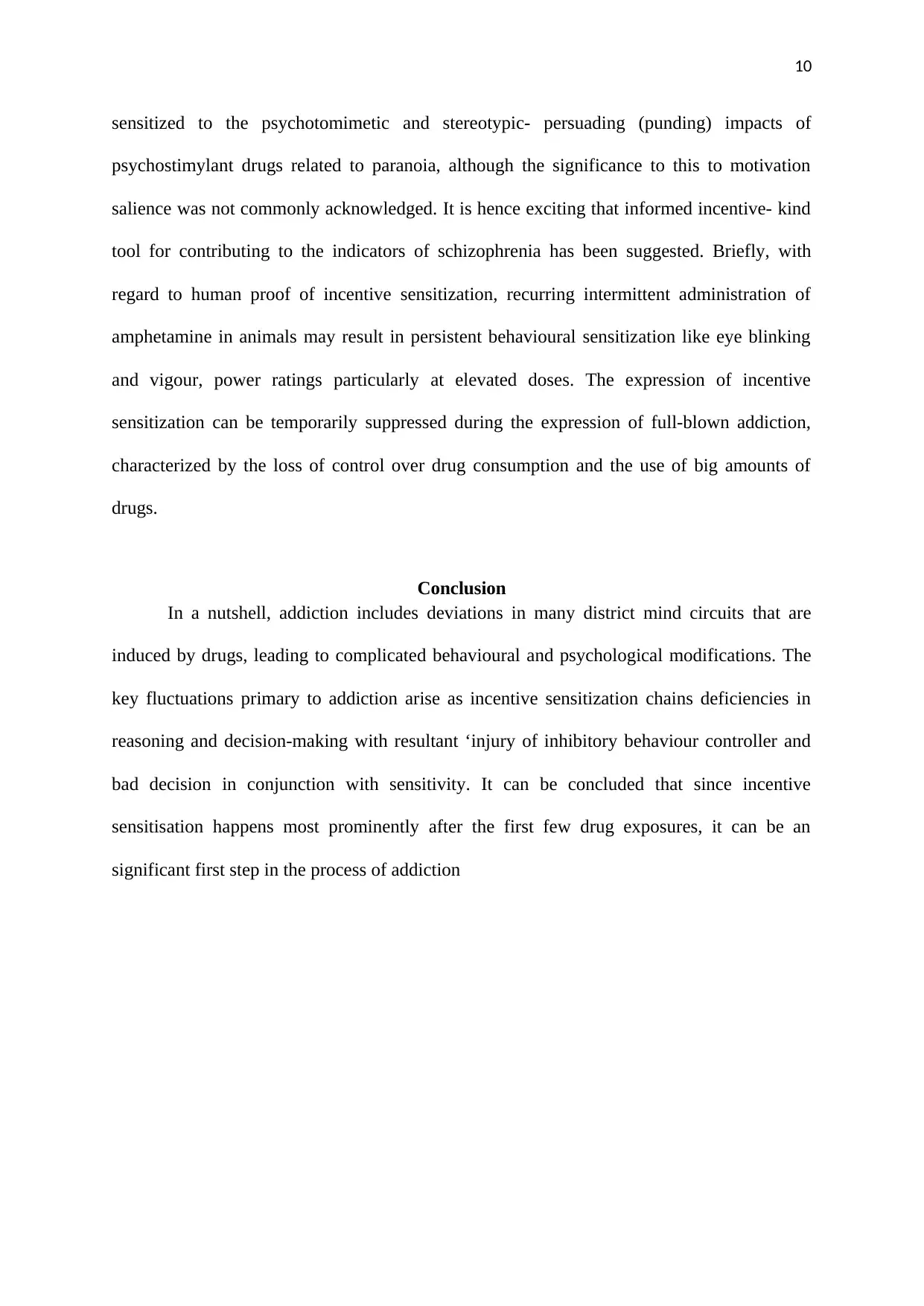
10
sensitized to the psychotomimetic and stereotypic- persuading (punding) impacts of
psychostimylant drugs related to paranoia, although the significance to this to motivation
salience was not commonly acknowledged. It is hence exciting that informed incentive- kind
tool for contributing to the indicators of schizophrenia has been suggested. Briefly, with
regard to human proof of incentive sensitization, recurring intermittent administration of
amphetamine in animals may result in persistent behavioural sensitization like eye blinking
and vigour, power ratings particularly at elevated doses. The expression of incentive
sensitization can be temporarily suppressed during the expression of full-blown addiction,
characterized by the loss of control over drug consumption and the use of big amounts of
drugs.
Conclusion
In a nutshell, addiction includes deviations in many district mind circuits that are
induced by drugs, leading to complicated behavioural and psychological modifications. The
key fluctuations primary to addiction arise as incentive sensitization chains deficiencies in
reasoning and decision-making with resultant ‘injury of inhibitory behaviour controller and
bad decision in conjunction with sensitivity. It can be concluded that since incentive
sensitisation happens most prominently after the first few drug exposures, it can be an
significant first step in the process of addiction
sensitized to the psychotomimetic and stereotypic- persuading (punding) impacts of
psychostimylant drugs related to paranoia, although the significance to this to motivation
salience was not commonly acknowledged. It is hence exciting that informed incentive- kind
tool for contributing to the indicators of schizophrenia has been suggested. Briefly, with
regard to human proof of incentive sensitization, recurring intermittent administration of
amphetamine in animals may result in persistent behavioural sensitization like eye blinking
and vigour, power ratings particularly at elevated doses. The expression of incentive
sensitization can be temporarily suppressed during the expression of full-blown addiction,
characterized by the loss of control over drug consumption and the use of big amounts of
drugs.
Conclusion
In a nutshell, addiction includes deviations in many district mind circuits that are
induced by drugs, leading to complicated behavioural and psychological modifications. The
key fluctuations primary to addiction arise as incentive sensitization chains deficiencies in
reasoning and decision-making with resultant ‘injury of inhibitory behaviour controller and
bad decision in conjunction with sensitivity. It can be concluded that since incentive
sensitisation happens most prominently after the first few drug exposures, it can be an
significant first step in the process of addiction
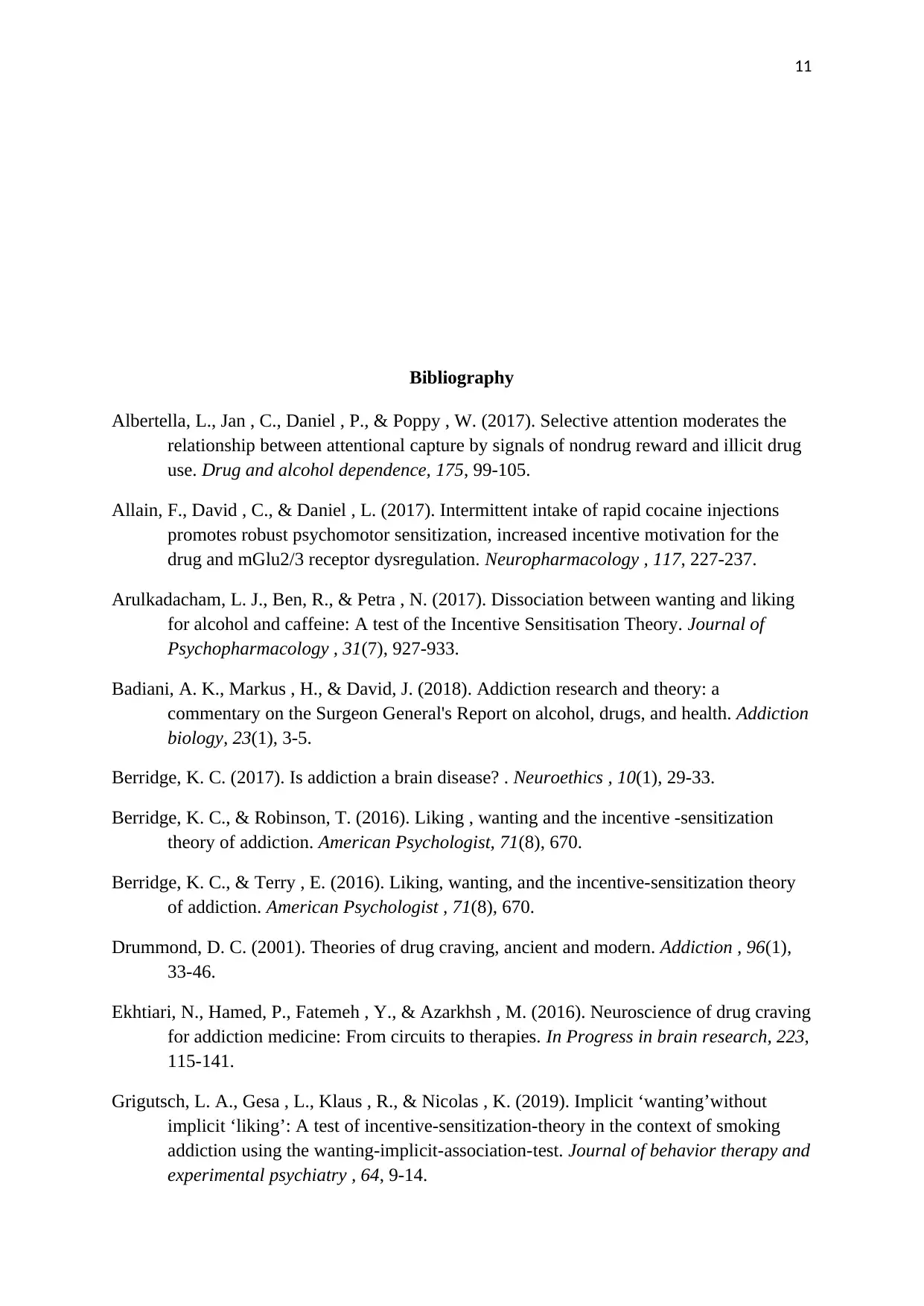
11
Bibliography
Albertella, L., Jan , C., Daniel , P., & Poppy , W. (2017). Selective attention moderates the
relationship between attentional capture by signals of nondrug reward and illicit drug
use. Drug and alcohol dependence, 175, 99-105.
Allain, F., David , C., & Daniel , L. (2017). Intermittent intake of rapid cocaine injections
promotes robust psychomotor sensitization, increased incentive motivation for the
drug and mGlu2/3 receptor dysregulation. Neuropharmacology , 117, 227-237.
Arulkadacham, L. J., Ben, R., & Petra , N. (2017). Dissociation between wanting and liking
for alcohol and caffeine: A test of the Incentive Sensitisation Theory. Journal of
Psychopharmacology , 31(7), 927-933.
Badiani, A. K., Markus , H., & David, J. (2018). Addiction research and theory: a
commentary on the Surgeon General's Report on alcohol, drugs, and health. Addiction
biology, 23(1), 3-5.
Berridge, K. C. (2017). Is addiction a brain disease? . Neuroethics , 10(1), 29-33.
Berridge, K. C., & Robinson, T. (2016). Liking , wanting and the incentive -sensitization
theory of addiction. American Psychologist, 71(8), 670.
Berridge, K. C., & Terry , E. (2016). Liking, wanting, and the incentive-sensitization theory
of addiction. American Psychologist , 71(8), 670.
Drummond, D. C. (2001). Theories of drug craving, ancient and modern. Addiction , 96(1),
33-46.
Ekhtiari, N., Hamed, P., Fatemeh , Y., & Azarkhsh , M. (2016). Neuroscience of drug craving
for addiction medicine: From circuits to therapies. In Progress in brain research, 223,
115-141.
Grigutsch, L. A., Gesa , L., Klaus , R., & Nicolas , K. (2019). Implicit ‘wanting’without
implicit ‘liking’: A test of incentive-sensitization-theory in the context of smoking
addiction using the wanting-implicit-association-test. Journal of behavior therapy and
experimental psychiatry , 64, 9-14.
Bibliography
Albertella, L., Jan , C., Daniel , P., & Poppy , W. (2017). Selective attention moderates the
relationship between attentional capture by signals of nondrug reward and illicit drug
use. Drug and alcohol dependence, 175, 99-105.
Allain, F., David , C., & Daniel , L. (2017). Intermittent intake of rapid cocaine injections
promotes robust psychomotor sensitization, increased incentive motivation for the
drug and mGlu2/3 receptor dysregulation. Neuropharmacology , 117, 227-237.
Arulkadacham, L. J., Ben, R., & Petra , N. (2017). Dissociation between wanting and liking
for alcohol and caffeine: A test of the Incentive Sensitisation Theory. Journal of
Psychopharmacology , 31(7), 927-933.
Badiani, A. K., Markus , H., & David, J. (2018). Addiction research and theory: a
commentary on the Surgeon General's Report on alcohol, drugs, and health. Addiction
biology, 23(1), 3-5.
Berridge, K. C. (2017). Is addiction a brain disease? . Neuroethics , 10(1), 29-33.
Berridge, K. C., & Robinson, T. (2016). Liking , wanting and the incentive -sensitization
theory of addiction. American Psychologist, 71(8), 670.
Berridge, K. C., & Terry , E. (2016). Liking, wanting, and the incentive-sensitization theory
of addiction. American Psychologist , 71(8), 670.
Drummond, D. C. (2001). Theories of drug craving, ancient and modern. Addiction , 96(1),
33-46.
Ekhtiari, N., Hamed, P., Fatemeh , Y., & Azarkhsh , M. (2016). Neuroscience of drug craving
for addiction medicine: From circuits to therapies. In Progress in brain research, 223,
115-141.
Grigutsch, L. A., Gesa , L., Klaus , R., & Nicolas , K. (2019). Implicit ‘wanting’without
implicit ‘liking’: A test of incentive-sensitization-theory in the context of smoking
addiction using the wanting-implicit-association-test. Journal of behavior therapy and
experimental psychiatry , 64, 9-14.
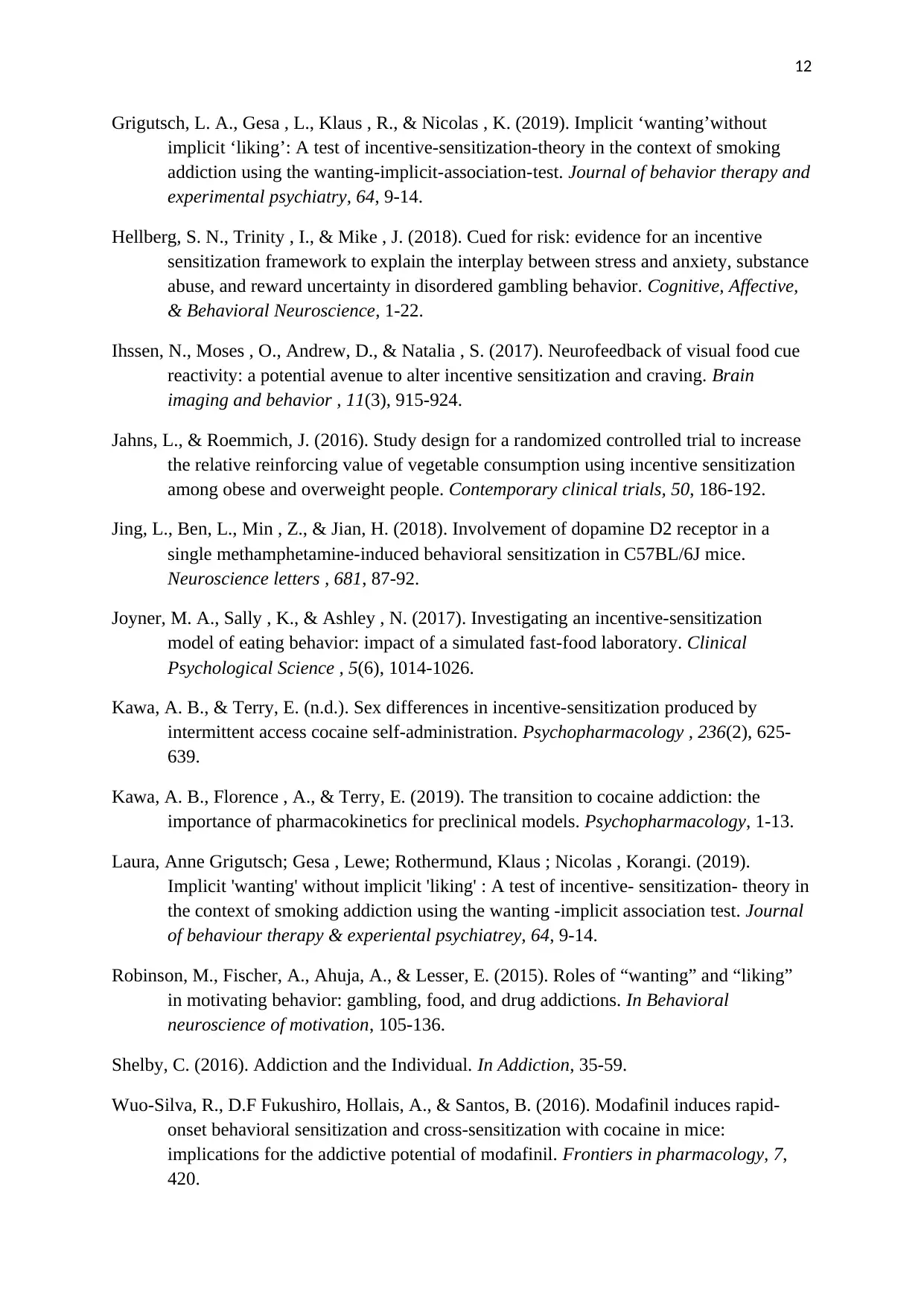
12
Grigutsch, L. A., Gesa , L., Klaus , R., & Nicolas , K. (2019). Implicit ‘wanting’without
implicit ‘liking’: A test of incentive-sensitization-theory in the context of smoking
addiction using the wanting-implicit-association-test. Journal of behavior therapy and
experimental psychiatry, 64, 9-14.
Hellberg, S. N., Trinity , I., & Mike , J. (2018). Cued for risk: evidence for an incentive
sensitization framework to explain the interplay between stress and anxiety, substance
abuse, and reward uncertainty in disordered gambling behavior. Cognitive, Affective,
& Behavioral Neuroscience, 1-22.
Ihssen, N., Moses , O., Andrew, D., & Natalia , S. (2017). Neurofeedback of visual food cue
reactivity: a potential avenue to alter incentive sensitization and craving. Brain
imaging and behavior , 11(3), 915-924.
Jahns, L., & Roemmich, J. (2016). Study design for a randomized controlled trial to increase
the relative reinforcing value of vegetable consumption using incentive sensitization
among obese and overweight people. Contemporary clinical trials, 50, 186-192.
Jing, L., Ben, L., Min , Z., & Jian, H. (2018). Involvement of dopamine D2 receptor in a
single methamphetamine-induced behavioral sensitization in C57BL/6J mice.
Neuroscience letters , 681, 87-92.
Joyner, M. A., Sally , K., & Ashley , N. (2017). Investigating an incentive-sensitization
model of eating behavior: impact of a simulated fast-food laboratory. Clinical
Psychological Science , 5(6), 1014-1026.
Kawa, A. B., & Terry, E. (n.d.). Sex differences in incentive-sensitization produced by
intermittent access cocaine self-administration. Psychopharmacology , 236(2), 625-
639.
Kawa, A. B., Florence , A., & Terry, E. (2019). The transition to cocaine addiction: the
importance of pharmacokinetics for preclinical models. Psychopharmacology, 1-13.
Laura, Anne Grigutsch; Gesa , Lewe; Rothermund, Klaus ; Nicolas , Korangi. (2019).
Implicit 'wanting' without implicit 'liking' : A test of incentive- sensitization- theory in
the context of smoking addiction using the wanting -implicit association test. Journal
of behaviour therapy & experiental psychiatrey, 64, 9-14.
Robinson, M., Fischer, A., Ahuja, A., & Lesser, E. (2015). Roles of “wanting” and “liking”
in motivating behavior: gambling, food, and drug addictions. In Behavioral
neuroscience of motivation, 105-136.
Shelby, C. (2016). Addiction and the Individual. In Addiction, 35-59.
Wuo-Silva, R., D.F Fukushiro, Hollais, A., & Santos, B. (2016). Modafinil induces rapid-
onset behavioral sensitization and cross-sensitization with cocaine in mice:
implications for the addictive potential of modafinil. Frontiers in pharmacology, 7,
420.
Grigutsch, L. A., Gesa , L., Klaus , R., & Nicolas , K. (2019). Implicit ‘wanting’without
implicit ‘liking’: A test of incentive-sensitization-theory in the context of smoking
addiction using the wanting-implicit-association-test. Journal of behavior therapy and
experimental psychiatry, 64, 9-14.
Hellberg, S. N., Trinity , I., & Mike , J. (2018). Cued for risk: evidence for an incentive
sensitization framework to explain the interplay between stress and anxiety, substance
abuse, and reward uncertainty in disordered gambling behavior. Cognitive, Affective,
& Behavioral Neuroscience, 1-22.
Ihssen, N., Moses , O., Andrew, D., & Natalia , S. (2017). Neurofeedback of visual food cue
reactivity: a potential avenue to alter incentive sensitization and craving. Brain
imaging and behavior , 11(3), 915-924.
Jahns, L., & Roemmich, J. (2016). Study design for a randomized controlled trial to increase
the relative reinforcing value of vegetable consumption using incentive sensitization
among obese and overweight people. Contemporary clinical trials, 50, 186-192.
Jing, L., Ben, L., Min , Z., & Jian, H. (2018). Involvement of dopamine D2 receptor in a
single methamphetamine-induced behavioral sensitization in C57BL/6J mice.
Neuroscience letters , 681, 87-92.
Joyner, M. A., Sally , K., & Ashley , N. (2017). Investigating an incentive-sensitization
model of eating behavior: impact of a simulated fast-food laboratory. Clinical
Psychological Science , 5(6), 1014-1026.
Kawa, A. B., & Terry, E. (n.d.). Sex differences in incentive-sensitization produced by
intermittent access cocaine self-administration. Psychopharmacology , 236(2), 625-
639.
Kawa, A. B., Florence , A., & Terry, E. (2019). The transition to cocaine addiction: the
importance of pharmacokinetics for preclinical models. Psychopharmacology, 1-13.
Laura, Anne Grigutsch; Gesa , Lewe; Rothermund, Klaus ; Nicolas , Korangi. (2019).
Implicit 'wanting' without implicit 'liking' : A test of incentive- sensitization- theory in
the context of smoking addiction using the wanting -implicit association test. Journal
of behaviour therapy & experiental psychiatrey, 64, 9-14.
Robinson, M., Fischer, A., Ahuja, A., & Lesser, E. (2015). Roles of “wanting” and “liking”
in motivating behavior: gambling, food, and drug addictions. In Behavioral
neuroscience of motivation, 105-136.
Shelby, C. (2016). Addiction and the Individual. In Addiction, 35-59.
Wuo-Silva, R., D.F Fukushiro, Hollais, A., & Santos, B. (2016). Modafinil induces rapid-
onset behavioral sensitization and cross-sensitization with cocaine in mice:
implications for the addictive potential of modafinil. Frontiers in pharmacology, 7,
420.
Paraphrase This Document
Need a fresh take? Get an instant paraphrase of this document with our AI Paraphraser

13
1 out of 14
Your All-in-One AI-Powered Toolkit for Academic Success.
+13062052269
info@desklib.com
Available 24*7 on WhatsApp / Email
![[object Object]](/_next/static/media/star-bottom.7253800d.svg)
Unlock your academic potential
© 2024 | Zucol Services PVT LTD | All rights reserved.